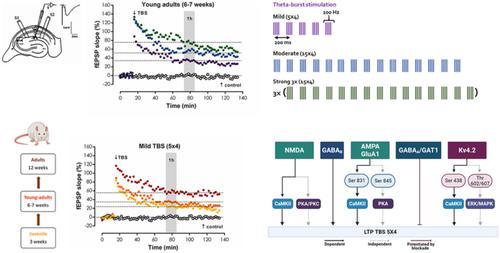当前位置:
X-MOL 学术
›
Eur. J. Neurosci.
›
论文详情
Our official English website, www.x-mol.net, welcomes your
feedback! (Note: you will need to create a separate account there.)
Hippocampal CA1 theta burst-induced LTP from weaning to adulthood: Cellular and molecular mechanisms in young male rats revisited
European Journal of Neuroscience ( IF 2.7 ) Pub Date : 2021-07-12 , DOI: 10.1111/ejn.15390 N. C. Rodrigues 1 , A. Silva‐Cruz 1 , A. Caulino‐Rocha 2, 3 , A. Bento‐Oliveira 2, 3 , J. A. Ribeiro 1, 4 , D. Cunha‐Reis 1, 2, 3
European Journal of Neuroscience ( IF 2.7 ) Pub Date : 2021-07-12 , DOI: 10.1111/ejn.15390 N. C. Rodrigues 1 , A. Silva‐Cruz 1 , A. Caulino‐Rocha 2, 3 , A. Bento‐Oliveira 2, 3 , J. A. Ribeiro 1, 4 , D. Cunha‐Reis 1, 2, 3
Affiliation

|
Long-term potentiation (LTP) is a highly studied cellular process, yet determining the transduction and gamma aminobutyric acid (GABAergic) pathways that are the essential versus modulatory for LTP elicited by theta burst stimulation (TBS) in the hippocampal Cornu Ammonis 1 (CA1) area is still elusive, due to the use of different TBS intensities, patterns or different rodent/cellular models. We now characterised the developmental maturation and the transduction and GABAergic pathways required for mild TBS-induced LTP in hippocampal CA1 area in male rats. LTP induced by TBS (5x4) (five bursts of four pulses delivered at 100 Hz) lasted for up to 3 h and was increasingly larger from weaning to adulthood. Stronger TBS patterns - TBS (15x4) or three TBS (15x4) separated by 6 min induced nearly maximal LTP not being the best choice to study the value of LTP-enhancing drugs. LTP induced by TBS (5x4) in young adults was fully dependent on N-methyl D-aspartate (NMDA) receptor and calmodulin-dependent protein kinase II (CaMKII) activity but independent of protein kinase A (PKA) or protein kinase C (PKC) activity. Furthermore, it was partially dependent on GABAB receptor activation and was potentiated by GABAA receptor blockade and less by GAT-1 transporter blockade. AMPA GluA1 phosphorylation on Ser831 (CaMKII target) but not GluA1 Ser845 (PKA target) was essential for LTP expression. The phosphorylation of the Kv4.2 channel was observed at Ser438 (CaMKII target) but not at Thr602 or Thr607 (ERK/MAPK pathway target). This suggests that cellular kinases like PKA, PKC, or kinases of the ERK/MAPK family although important modulators of TBS (5x4)-induced LTP may not be essential for its expression in the CA1 area of the hippocampus.
中文翻译:

从断奶到成年海马 CA1 theta 爆发诱导的 LTP:重新审视年轻雄性大鼠的细胞和分子机制
长时程增强 (LTP) 是一个经过高度研究的细胞过程,但它决定了转导和伽马氨基丁酸 (GABAergic) 通路,这些通路是由海马角突刺激 (TBS) 引起的 LTP 的基本与调节通路由于使用不同的 TBS 强度、模式或不同的啮齿动物/细胞模型,1 (CA1) 区域仍然难以捉摸。我们现在描述了雄性大鼠海马 CA1 区轻度 TBS 诱导的 LTP 所需的发育成熟和转导和 GABA 能途径。由 TBS (5x4) 诱导的 LTP(以 100 Hz 提供四次脉冲的五次突发)持续长达 3 小时,并且从断奶到成年期越来越大。更强的 TBS 模式 - 相隔 6 分钟的 TBS (15x4) 或三个 TBS (15x4) 诱导几乎最大的 LTP 不是研究 LTP 增强药物价值的最佳选择。TBS (5x4) 在年轻人中诱导的 LTP 完全依赖于 N-甲基 D-天冬氨酸 (NMDA) 受体和钙调素依赖性蛋白激酶 II (CaMKII) 活性,但不依赖于蛋白激酶 A (PKA) 或蛋白激酶 C (PKC) ) 活动。B受体激活并被 GABA A受体阻断增强,而 GAT-1 转运蛋白阻断则较少。AMPA GluA1 在 Ser 831(CaMKII 目标)而非 GluA1 Ser 845(PKA 目标)上的磷酸化对于 LTP 表达至关重要。在 Ser 438(CaMKII 目标)但未在 Thr 602或 Thr 607(ERK/MAPK 途径目标)处观察到 Kv4.2 通道的磷酸化。这表明细胞激酶如 PKA、PKC 或 ERK/MAPK 家族的激酶,尽管 TBS (5x4) 诱导的 LTP 的重要调节剂可能对其在海马 CA1 区的表达不是必需的。
更新日期:2021-08-17
中文翻译:

从断奶到成年海马 CA1 theta 爆发诱导的 LTP:重新审视年轻雄性大鼠的细胞和分子机制
长时程增强 (LTP) 是一个经过高度研究的细胞过程,但它决定了转导和伽马氨基丁酸 (GABAergic) 通路,这些通路是由海马角突刺激 (TBS) 引起的 LTP 的基本与调节通路由于使用不同的 TBS 强度、模式或不同的啮齿动物/细胞模型,1 (CA1) 区域仍然难以捉摸。我们现在描述了雄性大鼠海马 CA1 区轻度 TBS 诱导的 LTP 所需的发育成熟和转导和 GABA 能途径。由 TBS (5x4) 诱导的 LTP(以 100 Hz 提供四次脉冲的五次突发)持续长达 3 小时,并且从断奶到成年期越来越大。更强的 TBS 模式 - 相隔 6 分钟的 TBS (15x4) 或三个 TBS (15x4) 诱导几乎最大的 LTP 不是研究 LTP 增强药物价值的最佳选择。TBS (5x4) 在年轻人中诱导的 LTP 完全依赖于 N-甲基 D-天冬氨酸 (NMDA) 受体和钙调素依赖性蛋白激酶 II (CaMKII) 活性,但不依赖于蛋白激酶 A (PKA) 或蛋白激酶 C (PKC) ) 活动。B受体激活并被 GABA A受体阻断增强,而 GAT-1 转运蛋白阻断则较少。AMPA GluA1 在 Ser 831(CaMKII 目标)而非 GluA1 Ser 845(PKA 目标)上的磷酸化对于 LTP 表达至关重要。在 Ser 438(CaMKII 目标)但未在 Thr 602或 Thr 607(ERK/MAPK 途径目标)处观察到 Kv4.2 通道的磷酸化。这表明细胞激酶如 PKA、PKC 或 ERK/MAPK 家族的激酶,尽管 TBS (5x4) 诱导的 LTP 的重要调节剂可能对其在海马 CA1 区的表达不是必需的。











































 京公网安备 11010802027423号
京公网安备 11010802027423号